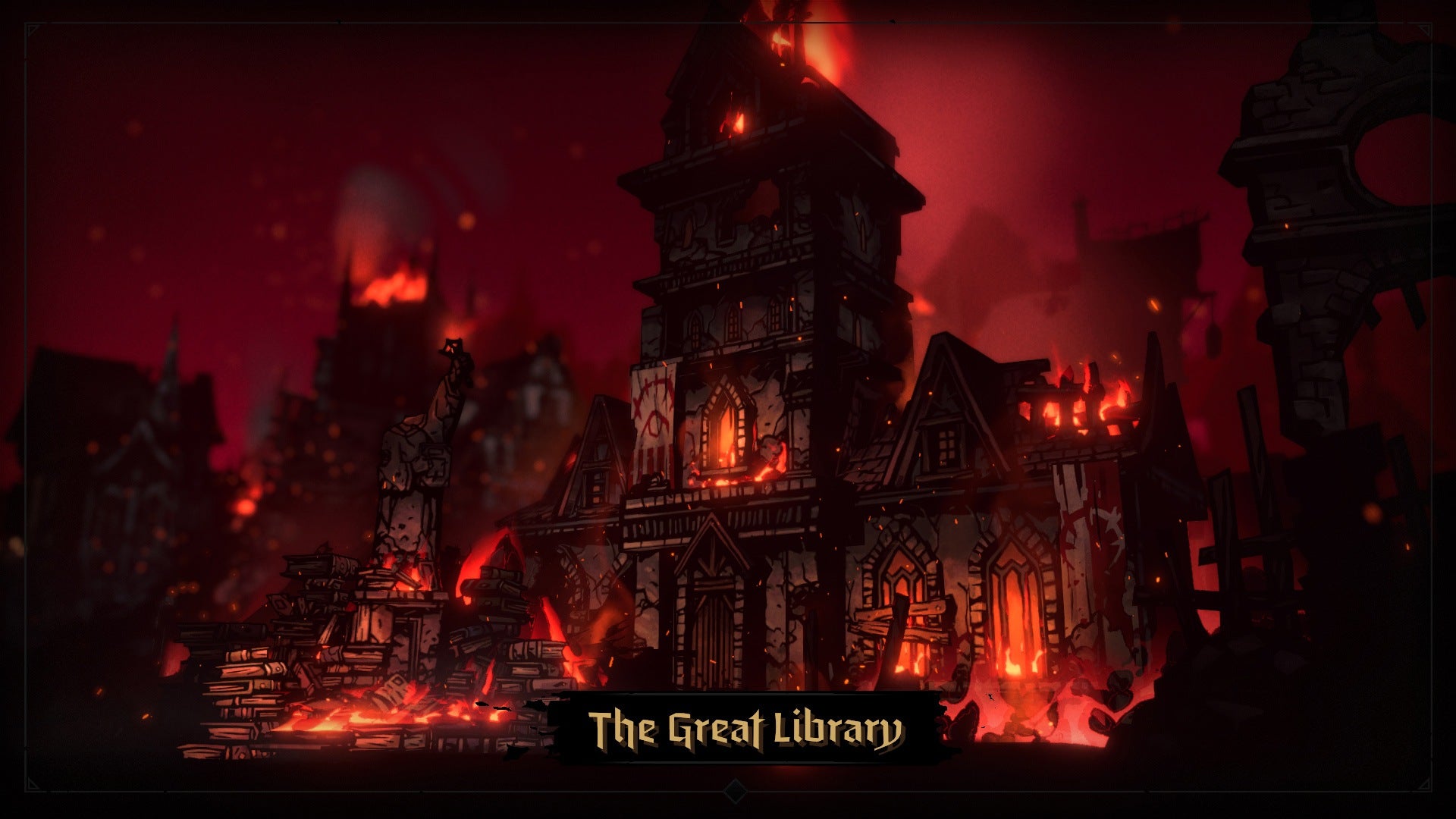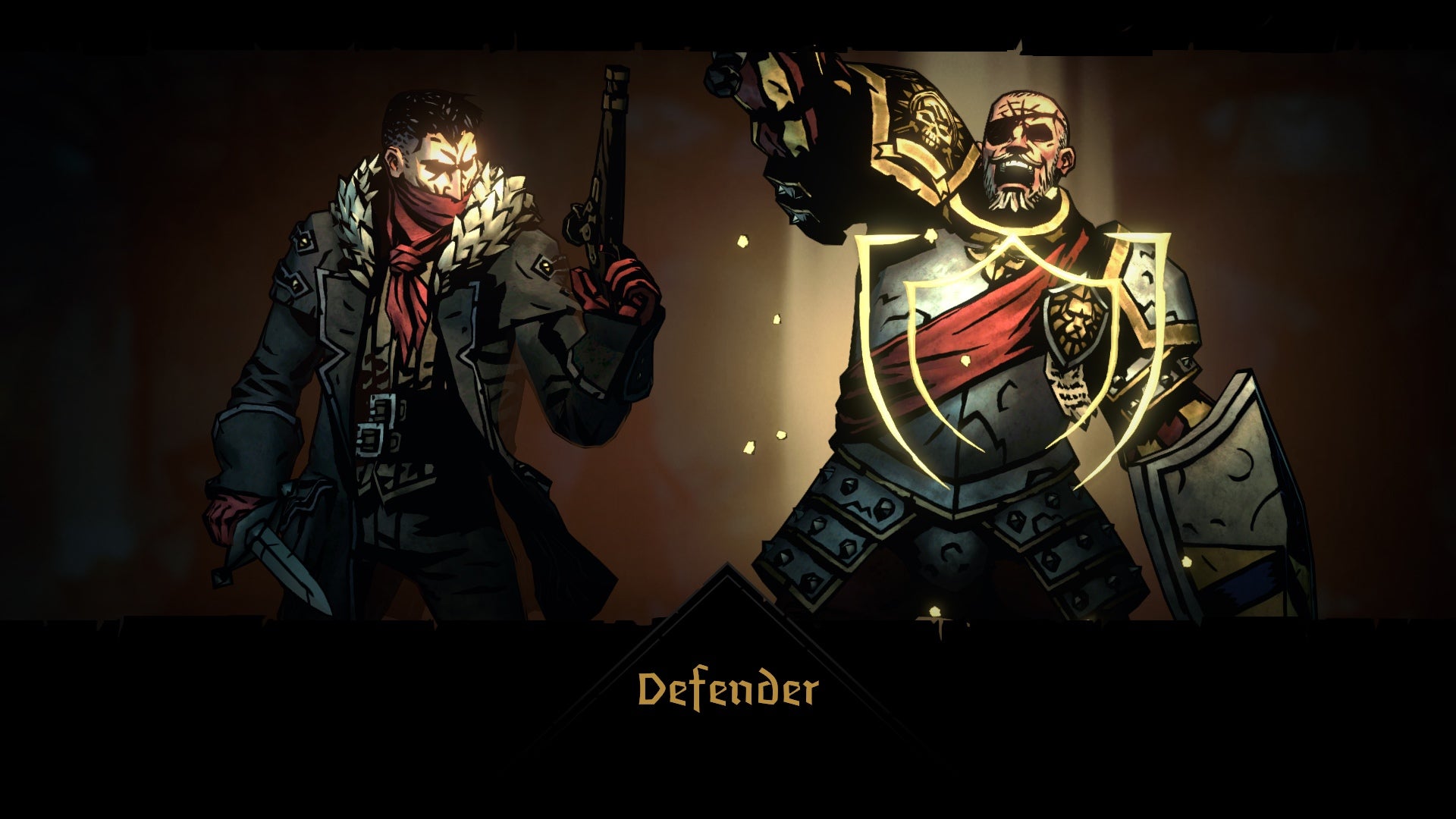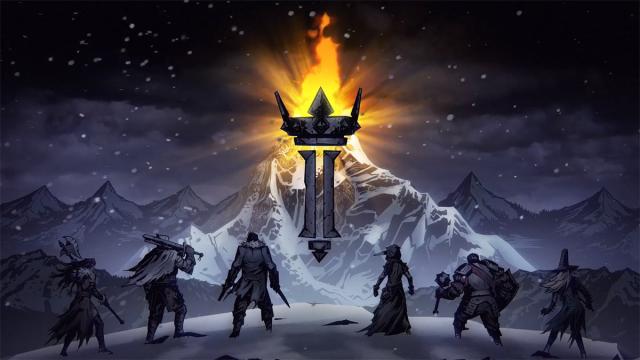Darkest Dungeon II is nothing if not evocative — a positive quirk it shares with the first game. When my party reaches the Mountain at its heart, they are brought low. This place has haunted their dreams for weeks — a different configuration for each of them.
The Plague Doctor sees a mountain of categorised meat, livers, kidneys, and throats, breathing in impossible arrangements. She is astounded by its regimented horror, and clings to the Graverobber’s side, who in turn sees a burial mound. The Man-At-Arms imagines its many peaks as an infantry formation, the ghosts of his dead men throwing themselves against it. He holds his partner, The Runaway (and Darkest Dungeon II’s newest class), close. She grips her spear in anticipation: here lies flaking viscera, exposed bone, and the shriveled almost red of scar tissue. It would be easier if I were only describing their nightmares. But some of them are dreams — hopes wrapped in flesh, dirt, and char.
For those of you who skipped the first game (you should go back and play it), Darkest Dungeon is a turn-based RPG that you could reasonably describe as a roguelike, though that undersells the premise. It follows you, the unnamed descendent of a once noble line returning to your family’s estate to uncover the eldritch rot beneath the grounds.

To do this, you assemble parties of dark fantasy adventurers, each of which is a member of a distinctive character class. You then send them into the depths of the estate to be murdered and repeatedly traumatized by the many horrifying abominations therein, all the while slowly rebuilding the nearby hamlet and tending to the wounds of those who manage to escape alive. These characters grow and change over the course of dozens of expeditions, developing new traits in accordance with their many traumas, which then change how they operate in combat. It is a game about becoming attached to people who you then make suffer. Grim, I know. The second game builds on this narratively and through its combat systems, but wildly diverges structurally — and I don’t know if it works.
Darkest Dungeon II ditches long-term character progression altogether, and switches to a firmly run-based model. For those of you familiar with it, think Slay the Spire but with traumatized weirdos instead of a deck of cards. That may sound reductive, like I’m underselling the game’s structural differences to make an easy comparison. I promise you I am not.
You traverse a map full of little nodes, each of which represents an encounter or opportunity to make a pivotal decision in your heroes’ journey. These nodes are connected with dotted, and solid lines, depending on whether or not you’ll have to fight enemies along your way. At the end of each map, you have an opportunity to heal and prepare for the next. It’s Slay the Spire to a t — all the way to the chained piece of anatomy you fight at the end of each run (in Slay the Spire its a heart, in Darkest Dungeon II its a brain). When you fail a run, and you will fail, your characters are dead and gone. Start over.
This is a strange directive for a series that prides itself on being about making the best of a bad situation. In the first game, when a run started to break bad, you had to make the anxiety-inducing choice to either commit and continue to the boss you may be unprepared for or to cut your losses and leave with the broken and battered members of your adventuring party. Doing this repeatedly would lead to your hamlet overflowing with the broken and scarred, and hardier adventurers would become fewer and further between. And yet, you would persist, recruit new heroes, and send them back into the darkest dungeon. Without this overarching structure, it’s hard not to abandon every expedition that gets off on the wrong foot.
Darkest Dungeon II tries to incentivise you to keep a doomed run going by promising more “hope” at the disastrous end of your journey. Hope is what Darkest Dungeon II calls experience, which you earn by doing…uh, everything. Defeating monsters? Hope. Moving forward? Hope. Talking to people? Hope. The list goes on.
Hope fills up a little bar. When that bar fills you move up a rank, and you get a bunch of fancy new unlocks. These unlocks include new trinkets, which are stat boosting equipment for your characters, new classes, and new traits and quirks for your characters to become afflicted with.
Darkest Dungeon felt like a revolution to me, and it made me fall in love with procedurally generated storytelling. It may not have been a fair expectation for the sequel, but I was desperate for the studio to blow me away again — and that hasn’t really happened on account of the game’s boring progression.
This isn’t to say that Darkest Dungeon II isn’t excellent so far. It is. The game’s combat is a great iteration on the original. Your characters, each of whom has their own suite of class abilities, feel distinct from one another. The Plague Doctor is your introductory healer and support, the crit-based Graverobber and high damage Highwayman are your heavy hitters, and the Man-At-Arms is your tank. Darkest Dungeon II also introduces the Runaway. A young woman who uses a flaming hand-spear to act as both a support and burn-based, damage over time DPS.
The turn-based combat feels great, especially with the new combo system. Certain abilities trigger an additional effect when they’re combined with other attacks. The Runaway, for example, will spread fire to nearby enemies when she combos, effectively doubling her status effect output. The Graverobber gains a massive crit boost, allowing her to dish out incredible, armour piercing damage with impunity. By default, you don’t have any way to combo enemies, or any abilities which trigger off of combos. Instead, you have to get through the game’s first map and upgrade your party members enough to actually set up and follow through on their promise, which makes the first map a bit of a slog.
Unlocking new abilities is also a bit arcane, but I love the idea in theory. Each character class has their own backstory, which you can experience by visiting a Hero Shrine. Hero Shrines force your characters to confront their past, doling out some delicious narrative tidbits to the player and unlocking new abilities, while also doing some of the most inventive things I’ve ever encountered in a turn-based combat system.
The Runaway, for example, opens with a turn-based stealth game as she sneaks her way out of an abusive nunnery. The Graverobber’s story requires you to manage the stress of being in an abusive marriage while attempting to poison your husband. The Plague Doctor debates her professor to death. The narratives on their own are good, but their delivery is some of the best I’ve ever seen.

Darkest Dungeon II also introduces a brand new relationship system that I would’ve killed for in the first game. Over the course of your run characters will banter and bicker — slowly growing closer to one another. Eventually, this will develop into a codified relationship.
On a recent run, my Man-At-Arms shared a hopeful bond with our Graverobber, became inseparable friends with my Plague Doctor, and had an amorous relationship with The Runaway. This meant that, basically every turn, he was cheering or being cheered on by his friends. He would dive in the way of powerful attacks, his friends would heal him, and attack enemies by his side. The squad was a rolling deathball held together by a very friendly middle aged man with a mace. Which made it all the more devastating when these relationships imploded in the face of eldritch horror.
The higher a character’s stress (which is the game’s second health system), the more likely they are to suffer a negative affinity change. Suffer enough stress and a character will have a meltdown. Meltdowns deal a ton of damage to the character and will tank all of their relationships, but clears most of their stress. A bad meltdown can see an entire party’s worth of friendships buckle under the weight of overwhelming monstrosities.
Which means that Darkest Dungeon II, at its best moments, is just as good at telling stories as its predecessor — they’re just more self contained now. Instead of the story of your hamlet — or any individual character — taking centre stage, the game now focuses on the story within individual runs. I could tell you every twist and turn in the story of my first game-winning run, because I fell in love with those characters over their two hour adventure.
The Runaway was young, desperate to fit in, and easily misunderstood. She struggled to develop relationships with the other party members for a long time, but never broke through the Graverobber’s tough emotional shell leading to their bitter rivalry. But by the end of the run, my Man-At-Arms recognised how genuine she was and fell for her. My Plague Doctor watched her own friendship collapse with the Graverobber, only for it to return even stronger at the party’s lowest moment.
I do not remember their names, but I do remember the way they touched each other’s lives — maybe that’s enough. In a decade, I hope I can think back on a completed version of Darkest Dungeon II as horrifying, ravenous, and unmistakably human.

Leave a Reply